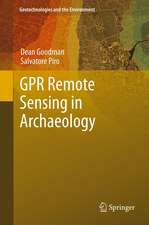Earth Structures: In Transport, Water and Environmental Engineering
Autor Ivan Vanicek, Martin Vaniceken Limba Engleză Paperback – 19 oct 2010
| Toate formatele și edițiile | Preț | Express |
|---|---|---|
| Paperback (1) | 1233.52 lei 6-8 săpt. | |
| SPRINGER NETHERLANDS – 19 oct 2010 | 1233.52 lei 6-8 săpt. | |
| Hardback (1) | 1244.08 lei 6-8 săpt. | |
| SPRINGER NETHERLANDS – 11 iul 2008 | 1244.08 lei 6-8 săpt. |
Preț: 1233.52 lei
Preț vechi: 1504.29 lei
-18% Nou
Puncte Express: 1850
Preț estimativ în valută:
236.04€ • 243.51$ • 196.97£
236.04€ • 243.51$ • 196.97£
Carte tipărită la comandă
Livrare economică 26 martie-09 aprilie
Preluare comenzi: 021 569.72.76
Specificații
ISBN-13: 9789048170036
ISBN-10: 9048170036
Pagini: 652
Ilustrații: XIII, 637 p.
Dimensiuni: 155 x 235 x 34 mm
Greutate: 0.9 kg
Ediția:Softcover reprint of hardcover 1st ed. 2008
Editura: SPRINGER NETHERLANDS
Colecția Springer
Locul publicării:Dordrecht, Netherlands
ISBN-10: 9048170036
Pagini: 652
Ilustrații: XIII, 637 p.
Dimensiuni: 155 x 235 x 34 mm
Greutate: 0.9 kg
Ediția:Softcover reprint of hardcover 1st ed. 2008
Editura: SPRINGER NETHERLANDS
Colecția Springer
Locul publicării:Dordrecht, Netherlands
Public țintă
ResearchCuprins
– Design Specification for Earth Structures.- Soil as a Construction Material.- Geosynthetics in Earth Structures.- Soil Improvement.- Limit States for Earth Structures.- Earth Structures in Transport Engineering.- Earth Structures in Water Engineering.- Earth Structures in Environmental Engineering.
Textul de pe ultima copertă
While soil is the oldest, most commonly used building material, there is a paradox in that the subject of Earth Structures has never previously been comprehensively covered. This book describes the principles of working with soil as a construction material, including two basic ways of treating it: geosynthetics and stabilization. The book discusses the design logic and ways to control Earth Structures, which differ significantly from other construction materials. Building with Earth involves greater uncertainty and risk, which means that there is a need for better design detailing and improvement in the quality of financial calculations.
The general part of the book gives a detailed description of the principles of limit states according to Eurocode 7, after which geotechnical design is also described. Subsequent chapters concentrate on earth structures for transport, water, and environmental projects.
The chapter on Earth Structures in transport engineering presents detailedcoverage of limit states of stability and deformation. Earth Structures in water engineering prioritizes the limit state of internal erosion. Earth Structures in environmental engineering describes new designs, in which part of the structure is created from non-standard materials which are usually susceptible to internal collapse, double porosity, unsaturation, etc. It also focuses on protecting the surrounding environment from contamination.
With its emphasis on principles, the logic of processes, and understanding the most important problems, the book allows all those involved with a construction (client, designer, contractor and supervisor) to build such earth structures more safely and economically.
Audience:
This book will be of interest to civil and environmental engineers; transport, hydraulic and planning engineers; geotechnical and geo-environmental engineers; scientists, designers, contractors, clients and supervisors; postgraduate students.
The general part of the book gives a detailed description of the principles of limit states according to Eurocode 7, after which geotechnical design is also described. Subsequent chapters concentrate on earth structures for transport, water, and environmental projects.
The chapter on Earth Structures in transport engineering presents detailedcoverage of limit states of stability and deformation. Earth Structures in water engineering prioritizes the limit state of internal erosion. Earth Structures in environmental engineering describes new designs, in which part of the structure is created from non-standard materials which are usually susceptible to internal collapse, double porosity, unsaturation, etc. It also focuses on protecting the surrounding environment from contamination.
With its emphasis on principles, the logic of processes, and understanding the most important problems, the book allows all those involved with a construction (client, designer, contractor and supervisor) to build such earth structures more safely and economically.
Audience:
This book will be of interest to civil and environmental engineers; transport, hydraulic and planning engineers; geotechnical and geo-environmental engineers; scientists, designers, contractors, clients and supervisors; postgraduate students.
Caracteristici
First complex elaboration of the problems of all earth structures types Soil as main structural material including its improvement using geosynthetics or stabilization is presented Limit states of earth structures are described in accordance with Eurocode 7 Considers the environmental aspects of waste in earth structures












